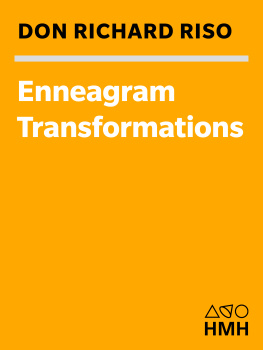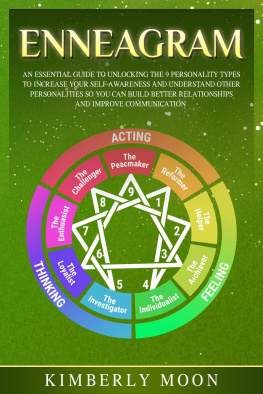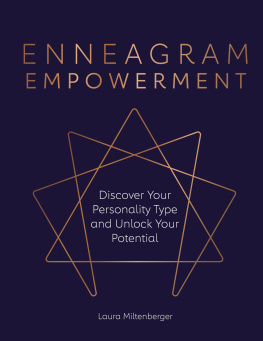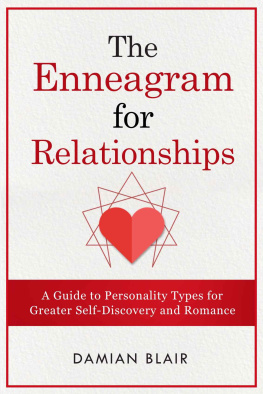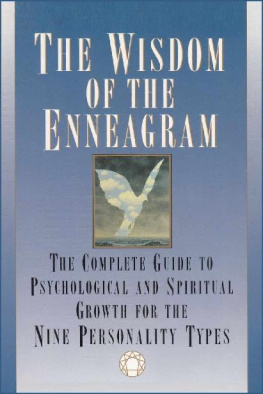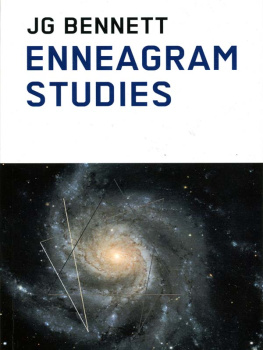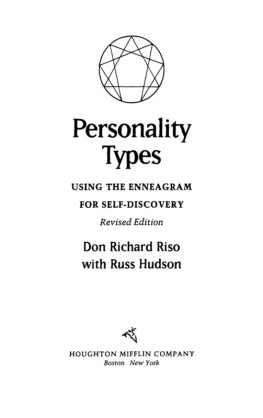Copyright 1993 by Don Richard Riso. All rights reserved.
No part of this work may be reproduced or transmitted in anyform or by any means, electronic or mechanical, including photocopying and recording, or by any information storage or retrieval system, except as expressly permitted by the 1976Copyright Act or in writing from the publisher. Requests for permission to reproduce any part of this book, including the Releasesand Affirmations for each personality type, should be addressedin writing to Houghton Mifflin Harcourt Publishing Company, 3 Park Avenue, 19th Floor, New York, New York 10016.
www.hmhco.com
Library of Congress Cataloging-in-Publication Data
Riso, Don Richard.
Enneagram transformations : releases and affirmations for
healing your personality type / Don Richard Riso.
p. cm.
ISBN 0-395-65786-5 (pbk.)
1. EnneagramProblems, exercises, etc. 2. Personality
changeProblems, exercises, etc. 3. Affirmations.
I. Title.
BF 698.35. E 54 R 57
155.26dc20 92-28727
CIP
Line drawings by Mark Desveaux
eISBN 978-0-547-52565-5
v2.1117
For
BETTE
Acknowledgments
Readers and colleagues have been asking where I get my material, especially since my books have been appearing rather rapidly now. There are several answers to that question, although they can probably be reduced to two. First, the world, and especially people, are endless sources of material for Enneagram booksonce one learns to see the types correctly. An extraordinary amount of knowledge can be had by noticing what is right under your nose. The hardest part is, of course, to put ones preconceptions aside to observe real people in the real world. But if one does so, the material seems to present itself. All one has to do is write it down.
Ideas for Enneagram books have also been suggested by my students, and this particular book, Enneagram Transformations, is a case in point. George Kwast, a graduate of my Trainings, suggested that I write affirmations for each personality type that could be read in times of crisis. George felt that it would be useful if I provided readers with a tool they could use when they were anxious, under stress, or otherwise in danger of spiraling down the Levels of Development into unhealthy states. He also felt that if people were already in a crisis, and feeling threatened and imbalanced, affirmations would be a helpful way of moving them out of their painful state. I have taken Georges suggestion, and the result is this book. I am indebted to him, as is anyone who benefits from these Transformations.
I am equally in debt to my editor at Houghton Mifflin, Ruth Hapgood. The birth of this book was so sudden that it was as much a surprise to me as it was to my publisher, Houghton Mifflin. When I presented Ruth with the manuscript, her enthusiasm was extremely encouraging. She also wanted the book to be published promptly so that readers could benefit from the Transformations. Without Ruths support, this book could not have been made available so quickly.
The warmth and professionalism of Sue Tecce, Ruths editorial assistant, is also greatly appreciated. Phone calls flew between New York and Boston as we shaped the manuscript, and Sue was on top of every situation with her usual thoroughness and thoughtfulness. Dorothy Paschal, the manuscript editor, helped me bring more clarity and simplicity to the book.
Other students have also contributed in various ways. Barbara Hribar wrote her own Enneagram affirmations at my first Professional Training in 1990, thus inspiring George and planting the seed for this book. Colleen McDonald advised me about using affirmations, as did Betsey Bittlingmaier, Ph.D., who also field-tested them with her therapy groups. Phyllis Houck Cloninger and Linda Donohue also encouraged me with this project. Brian Taylor has continued to supply shrewd good sense and valuable advice at every turn, as have Bradshaw and Digby. They all have my affectionate and heartfelt thanks.
My assistant, Russ Hudson, has, in terms of the actual writing of this book, contributed more than anyone else. Russ urged me to get inside each of the types more deeply, and he continued to press me until we both felt that we had done so. I say we because the Transformations reflect our ongoing collaboration about the Enneagram. He is in a very true sense the co-author of this book. However helpful you feel the Transformations are, they would not have been nearly so without his many suggestions and contributions. Would that every writer had an assistant as dedicated and talented as Russ.
PART I
Releasing Our Pain, Affirming Our Strength
Transformation and the Enneagram
These Transformations (as I have named the Re-leases and Affirmations for each personality type) are but one answer to the often asked question of students new to the Enneagram, Now that I know my type, what can I do with it?
One important answer is that knowing our type helps us become more conscious self-observers, and self-observation is necessary if we are to become free of our unthinking, mechanical reactions. If we do not observe ourselves, we cannot ever hope to be our own master. We will be like marionettes yanked by every impulse tugging on our strings.
If we learn to observe ourselves, however, we create the possibility of consciously choosing our behavior, and thereby of living more effectively. To do this, we must learn how not to identify with our personalityand this is where the Enneagram can be extremely valuable. Paradoxically, we need to see our personality in operation before we can learn how not to identify with it. We must experience the process of disidentifying with our personality and its habitual responses many times before we can acquire a taste for nonidentification and thus become convinced of its worthwhile results in our lives.
If we observe ourselves carefully, we will discover that most of what goes on in us is the constant churning of our mechanical responses, little more than the machinery of our personality grinding along pretty much on its own. We find that our attention is constantly possessed by ever-changing fears and desires, fantasies and associations, that lead nowhere while keeping us out of touch with our deeper self. Ironically, we build our identity out of these chaotic and unconscious impulsesembracing them as our self, and defending them with our life.
Ideas about observing ourselves, learning how not to identify with our personality, and of practicing nonidentification with our ego sound foreign and are rather threatening to most of us. And yet, if we think about it, we can probably recall moments of spontaneous nonidentification: most of us have experienced times when we were free from our personality and its (usually negative) responses. Sometimes a life-threatening crisis brings such a moment; sometimes an act of selfless love, an experience of the grandeur of nature, or an encounter with death wakes us up to something deep in us that is not our personality and is also clearly not the product of our ego. Moments such as these are vivid and profoundly liberating. Looking back on them, we usually regard them as the times when we were most alive.
An important part of our spiritual quest, then, becomes learning to have moments such as these more often. We need to find a way of waking up and of being more present to our own lives so that they can happen more frequently. There is no better tool than the Enneagram to help us observe ourselves, and thereby get some distance on our personality. The more we look into it, the more we will discover that getting distance on our personality is a very good thing indeed. When we learn to disidentify with our personality, instead of feeling naked and deprived, we find that our personality is actually what has blocked us most of our lives. Rather than having been our ally, our personality has been our secret enemy; rather than help us live more effectively, it has gotten in our way; rather than make us stronger, it has made us weaker and more afraid.
Next page
